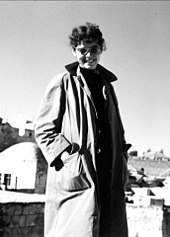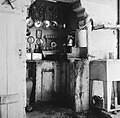Helen Keizer
Helen Keizer (born August 27, 1926 in Zug ; † December 20, 2013 there ) was a Swiss writer , painter and photographer . Between 1950 and 1990 she traveled to all Arab countries and in the 1970s and 1980s she had the reputation of being one of the most profound experts in this region.
Life
Keizer was the daughter of a teacher who took her on mountain tours and river trips from an early age. After finishing school in Zug, she attended the Zurich School of Applied Arts in the early 1940s and completed various internships as a graphic designer and decorator. An art history study tour of the École du Louvre in Paris, which led to Greece, Turkey, Lebanon and Syria, was groundbreaking for her in 1952 .
In 1954 Keizer traveled with a friend in the footsteps of Sven Hedin's “Land Route to India” and spent twelve months in Lebanon, Syria, Iraq, Iran, Pakistan, Afghanistan, India and Sri Lanka.
In the mid-1950s she worked as a journalist for various magazines, including a. the magazine Die Woche . In 1956 she traveled to Morocco and in 1957 wrote the first of 13 books with the title Salaam for Walter Verlag . Log of a trip to the Orient . The fee moved her to become a writer. As an independent author and journalist, she subsequently led a meager life.
Further trips followed, including to Lebanon, Syria and Iraq, where Keizer first made contact with archaeologists in the south and visited the ruins of Ur, Uruk, Nippur and Babylon. The Orient became more and more her destiny, writing and painting her necessity. On the way in the Orient, she encountered surprising helpfulness and hospitality. This also applied to her as a woman who was not only treated with respect, but who, as a single traveler, also received the hospitality that was otherwise reserved for men.
Keizer experienced sandstorms, droughts and raids, but also saw the hard fate of the Fellahs , who tilled their barren fields with the most primitive means. As a woman, she also managed to gain insights into the everyday lives of women and girls that a man would never have been able to experience. On long camel rides in the desert, she won friendship and trust with the Bedouins, and months of travel turned into years.
After further trips, Keizer went to Damascus to study language in 1959 and then spent several months in Jordan, where she was received by King Hussein and visited the ancient Nabatean city of Petra . In the refugee camps of the kingdom she first encountered the question of Palestine, a contact that she deepened on later visits and, years later, after the Six Day War of 1967, in the book Do not go across the Jordan. Fate of Palestine ended.
In 1961 Keiser's second book, Vagabund im Morgenland, was published . From 1962 on, she went on lecture tours twice a year in Germany, Austria and Switzerland for the next 26 years. She wrote reports on the history, archeology and customs of the Orient, which appeared in magazines such as DU and Atlantis . She also had her first solo exhibitions as a painter.
In the 1960s and 1970s Keizer traveled again to North Yemen, to Hadramaut , to Saudi Arabia, where she was received by King Feisal as a guest of the country , to Iraq, where she took part in excavations in Mesopotamia , and again to Jordan and in Israel, Kuwait, Oman, Egypt and Syria.
In 1983 she received the recognition award of the Canton of Zug for her contribution to international understanding. In 1995 she finished her work as a publicist with the book Die Oase . In 1998 a video portrait of Christoph Kühn appeared: Salaam. Helen Keizer - nomad from the West . In 2002, the Ethnographic Museum of the University of Zurich took over part of Keizer's photographic work. In 2003 she exhibited her watercolors and acrylic paintings for the last time in Zug. In the same year she traveled to Damascus, where the Syrian National Museum showed her photo exhibition Salaam . In Syria, she also traveled to Palmyra .
In 2016 Keiser's watercolors and acrylic paintings were on view in Zug's Altstadthalle . The exhibition was called “The Dream of Peace”.
Services
The Neue Zuger Zeitung reported: «Helen Keizer has traveled, got to know and researched the Arab countries from Lebanon and Syria to Saudi Arabia, Oman and Yemen for more than four decades. She passionately and tirelessly pleads for understanding and respect between Orient and Occident.
In her books Helen Keizer describes the change of entire societies, the abandonment of ancient traditions in favor of a modern, western standard of living. On the one hand, her literary work and the articles that Helen Keizer has written over the past 50 years, on the other hand, the numerous lectures that she has given beyond the Swiss borders, are documents that are of particular value as a source of contemporary history ».
Exhibitions
- Watercolors and oil pastel pictures, unknown gallery, Zug, 1958
- Watercolors and oil pastel pictures, unknown gallery, Zug, 1968
- Watercolors, unknown gallery, Zug, 1975
- Watercolors and acrylic paintings, Galerie Goldgasse, Zug, 1981
- Acrylic paintings, Kolin Gallery, Zug, 1985
- Aquarelle, Reto Locher, Hausen a. Albis, 1991
- Watercolors and acrylic paintings, Galerie zur Münz Zug, 1997
- Watercolors and acrylic paintings, Galerie zur Münz, Zug, 2003
- Watercolors and acrylic paintings, Altstadthalle , Zug, 2016
- Photo exhibition Salaam - Helen Keizer's photographic treasure from vanished Arabia
- 2002: Altstadthalle, Zug; Schmukuku Gallery, Zug; Helping, Zurich
- 2003: National Museum, Damascus
- 2004: Biblioteca Cantonale, Bellinzona ; Municipal Picture Gallery, Plovdiv ; Sofia University
Awards
1983: Recognition award from the Canton of Zug for Helen Keiser's complete works as a contribution to international understanding.
Works
Photographs
The Völkerkundemuseum Zürich owns parts of Helen Keizer's photographic work.
Helen Keizer developed the following slide presentations:
- Gods and kings in the old Mesopotamia
- Archaeologists around the Babylonian Tower
- Shine of the caliphs. Forgotten Islamic Culture
- The desert. Habitat and Threat
- The Bedouins
- Jordan. Kingdom on the edge of the desert
- Petra, the red rock city of the Nabataeans
- Yemen. Land of mountains and builders
- Oman. Land on the edge of the world
- Hadramaut - Adventure South Arabia
Books
- Salaam. Log of a trip to the Orient. Illustrations and photos by Helen Keizer. Swiss publishing house, Zurich 1958.
- Vagabond in the Orient. Illustrations and photos by Helen Keizer. Swiss publishing house, Zurich 1961.
- They came from the desert. With Bedouins in the footsteps of the ancient Nabataeans. Experiences and discoveries in Petra. Illustrations and photos by Helen Keizer. Walter Verlag, Olten 1964.
- The city of the great goddess. 4000 years of Uruk. With archaeologists between the Euphrates and Tigris. Photos and drawings by Helen Keizer. Walter Verlag, Olten 1967.
- Arabia. The countries of the Arabian Peninsula. Photos Helen Keizer. Silva Verlag, Zurich 1971.
- Don't go across the Jordan. Fate of Palestine. Rex Verlag, Lucerne 1971.
- The little Bedouin woman. Paths between desert and paradise. Rex Verlag, Lucerne 1975.
- Black gold adventure. Experiences and encounters in Saudi Arabia. Photos Helen Keizer. Rex Verlag, Lucerne 1977.
- The sons of Nabayot. Bedouins, researchers and adventurers in the rock city of Petra. Walter-Verlag, Olten 1977.
- Find Sindbad. Oman, the land of frankincense, and the ancient South Arabian cultures. Illustrations and photos by Helen Keizer. Walter Verlag, 1979.
- Call of the muezzin. A difficult love between Orient and Occident. Rex Verlag, Lucerne 1981.
- Son of the Bedouin. Rex Verlag, Lucerne 1983.
- Clouds over Corsica. Memoirs of a donkey driver. Rex Verlag, Lucerne 1986.
- The oasis. Giger & Kurz publishing house, Zug 1995.
- The blue donkey. A picture story from the desert. Pictures Helen Keizer. Helen Keizer, 1997.
- Salaam. Vanished Arabia. Photographs and texts by Helen Keizer. Scheidegger & Spiess Verlag, Zurich 2002.
photos
It was important to Helen Keizer to document her travels in order to convey the magic of the Orient as unbroken as possible to those who stayed at home. As a result, she not only took photos and took notes, but also drew and watercolored. In her backpack, which weighed ten kilograms, she always had drawing paper and watercolors with her. Back in Zug, she created her pictures, first watercolors, later with acrylic paints.
literature
- Swiss Foundation for Photography (Ed.): Photography in Switzerland from 1840 to today. Benteli, Bern 1992.
- Arnold Hottinger: The Arab World in Pictures. In: Christoph Kühn (Ed.): Helen Keizer. Salaam. Vanished Arabia. Photographs and texts. Scheidegger & Spiess Verlag, Zurich 2002, ISBN 3-85881-139-4 .
- Christoph Kühn: The lonely she-wolf - Helen Keizer: traveler, writer, photographer and painter. In: Christoph Kühn (Ed.): Helen Keizer. Salaam. Vanished Arabia. Photographs and texts. Scheidegger & Spiess Verlag, Zurich 2002, ISBN 3-85881-139-4 .
- Christoph Kühn: Images and encounters. In: Gemeinnützige Gesellschaft des Kantons Zug (Ed.): Borders. Zuger Neujahrsblatt 2002. Kalt-Zehnder-Druck, Zug 2001, ISBN 3-85761-278-9 .
- Teaching materials from the intercantonal teaching materials center (publisher): Time. Helen Keizer. In: World of Words. Volume 2, Lehrmittelverlag des Kantons Zürich, 1984.
- Markus Schürpf: Train in the picture. A journey through 150 years of photography history in Zug. In: Tugium. No. 28, 2012, pp. 83–128.
- Herman Steiner (Ed.): The Canton of Zug and its Photographers 1850–2000. Also a piece of cultural history. Zürcher Druck + Verlag AG, Rotkreuz 2000, ISBN 978-3-909287-20-8 .
Web links
- Internet presence Helen Keizer
- Georg Sütterlin: On the way to kings and Bedouins. In: Neue Zürcher Zeitung. June 2, 2002
- Andreas Faessler: "Nomad from the * Occident": The Zug travel writer and photographer Helen Keizer has died. In: Neue Zuger Zeitung. December 28, 2013
- Ignaz Staub: Got there just in time. In: Journal 21.ch. 1st of January 2014
Individual evidence
- ↑ Christoph Kühn: Invitation - “Salaam. Helen Keizer's photographic treasure from vanished Arabia ”. An exhibition in the Helferei, Zurich, the Altstadthalle , Zug and the Schmukuku Gallery, Zug, June to July 2002
- ↑ Ronald Schenkel: The Bedouin only lives in books. In: Neue Zuger Zeitung. Interview in August 23, 1996
| personal data | |
|---|---|
| SURNAME | Keizer, Helen |
| BRIEF DESCRIPTION | Swiss writer, painter and photographer. Connoisseur of the Orient |
| DATE OF BIRTH | August 27, 1926 |
| PLACE OF BIRTH | train |
| DATE OF DEATH | 20th December 2013 |
| Place of death | train |












